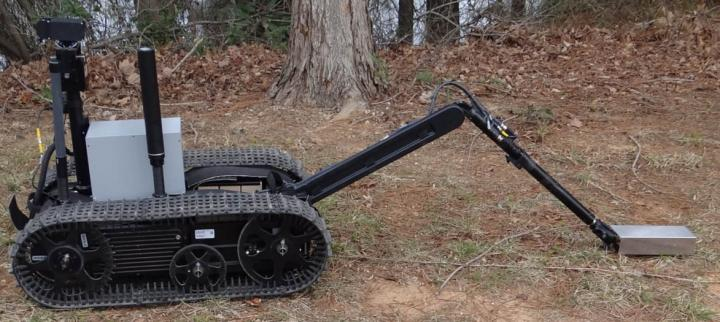Aug 19 2020
In conflict regions, landmines pose a major threat, but modern detection systems find it hard to differentiate between clutter and explosives.
 The technology can be easily transported to conflict areas via Army unmanned ground vehicles such as the TALON from QinetiQ North America. Image Credit: US Army.
The technology can be easily transported to conflict areas via Army unmanned ground vehicles such as the TALON from QinetiQ North America. Image Credit: US Army.
Researchers have created a new technique for identifying landmines, as part of a project financially supported by the Army. The technique can significantly decrease false alarm rates.
If false alarms could be reduced, the cost of humanitarian landmine clearance operations can also be reduced, offering greater mobility via road by preventing unwanted diversions in the route. The new technology can help detect landmines without the need to dig.
Named Vibration-ENhanced Underground Sensing system, or VENUS for short, the new framework was developed as part of a collaboration between Vadum, Inc., North Carolina State University, the Georgia Institute of Technology and the Army Research Office, an element of the U.S. Army Combat Capabilities Development Command’s Army Research Laboratory.
New concepts are rare in the area of landmine detection. This advance has the potential to be a game changer.
Dr James Harvey, Program Manager, ARO
The research was financially supported by the Night Vision and Electronic Sensors Directorate of the U.S. Army CCDC C5ISR Center as part of an Army Small Business Technology Transfer grant controlled by ARO.
A majority of the traditional landmine detectors work based on the detection of the electromagnetic signature of the mine itself, which can be easily mistaken for other buried metal objects or wet or magnetic soil patches.
The new technology, described in the proceedings of the 2020 SPIE Defense & Commercial Sensing Conference, stimulates the tiny metal parts within the landmine to vibrate by making use of a pulsed magnetic field.
Most of the other buried objects do not respond to the magnetic pulse, and a few objects that respond exhibit highly distinct vibrational characteristics. An exclusive vibrometer with a high dynamic range and the ability to differentiate between closely spaced low-frequency vibrations detects the different vibrations.
This new capability resulted from combining exciting results from several previous ambitious research projects and is an outstanding example of the transition from university basic research to new military and commercial technology capabilities.
Michael Steer, Professor and Research Partner, NC State University
Steer added, “The mathematical algorithms behind the detection depend on understanding the details of the interaction of magnetic fields, radar pulses, and vibrating components within the landmine as well as with the properties of various soil and clutter objects. Advancing university physical models and analysis continue to support the improvement of the detection algorithms.”
The research group was awarded an additional two-year Phase II STTR contract by the Army to advance its exclusive technology.
As part of the award, the researchers will work to reinforce and miniaturize the detection device for dependable outdoor testing at an Army range. Moreover, the team will gather information from real landmines in a range of soil conditions and exhibit the performance of the technology in stressing and challenging field conditions.
Because conventional metal detectors and ground penetrating radar rely on similar same fields, it should eventually be possible to upgrade conventional systems with VENUS technology to maximize detection capability.
Dr Josh Wetherington, Principal Researcher, Vadum, Inc.